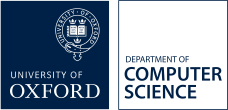Analysis I: Sequences and Series: 2008-2009
Term | Michaelmas Term 2008 (14 lectures) |
Overview
In these lectures we study the real and complex numbers and study their properties, particularly completeness; define and study limits of sequences, convergence of series, and power series.Learning outcomes
Student will have
- An ability to work within an axiomatic framework.
- A detailed understanding of how Cauchy's criterion for the convergence of real and complex sequences and series follows from the completeness axiom for
 , and the ability to explain the steps in standard mathematical notation.
, and the ability to explain the steps in standard mathematical notation. - Knowledge of some simple techniques for testing the convergence of sequences and series, and confidence in applying them.
- Familiarity with a variety of well-known sequences and series, with a developing intuition about the behaviour of new ones.
- An understanding of how the elementary functions can be defined by power series, with an ability to deduce some of their easier properties.
Synopsis
Real numbers: arithmetic, ordering, suprema, infima; the real numbers as a complete ordered field. The reals are uncountable. The complex number system. The triangle inequality.
Sequences of real or complex numbers. Definition of a limit of a sequence of numbers. Limits and inequalities. The algebra of limits. Order notation:  ,
,  .
.
Subsequences; a proof that every subsequence of a convergent sequence converges to the same limit; bounded monotone sequences converge. Bolzano-Weierstrass Theorem. Limit point of a set. Cauchy's convergence principle.
Series of real or complex numbers. Convergence of series. Simple examples to include geometric progressions and some power series. Absolute convergence, comparison test, ratio test, integral test. Alternating series test.
Power series, radius of convergence; important examples to include the exponential, cosine and sine series.
Reading list
- Robert G. Bartle, Donald R. Sherbert, Introduction to Real Analysis (Wiley, Third Edition, 2000), Chapters 2, 3, 9.1, 9.2.
- R. P. Burn, Numbers and Functions, Steps into Analysis (Cambridge University Press, 2000), Chapters 2-6. [This is a book of problems and answers, a DIY course in analysis.]
- J. M. Howie, Real Analysis (Springer Undergraduate Texts in Mathematics Series), ISBN 1-85233-314-6.
Alternative reading
The first five books take a slightly gentler approach to the material in the syllabus, whereas the last two cover it in greater depth and contain some more advanced material.
- Mary Hart, A Guide to Analysis (MacMillan, 1990), Chapter 2.
- J. C. Burkill, A First Course In Mathematical Analysis (CUP, 1962), Chapters 1, 2 and 5.
- K. G. Binmore, Mathematical Analysis, A Straightforward Approach (Cambridge University Press, second edition, 1990), Chapters 1-6.
- Victor Bryant, Yet Another Introduction to Analysis (Cambridge University Press, 1990), Chapters 1 and 2.
- G. Smith, Introductory Mathematics: Algebra and Analysis (Springer-Verlag, 1998), Chapter 3 (introducing complex numbers).
- Michael Spivak, Calculus (Benjamin, 1967), Parts I, IV, and V (for a construction of the real numbers).
- Brian S. Thomson, Judith B. Bruckner, Andrew M. Bruckner, Elementary Analysis (Prentice Hall, 2001), Chapters 1-4.
Taking our courses
This form is not to be used by students studying for a degree in the Department of Computer Science, or for Visiting Students who are registered for Computer Science courses
Other matriculated University of Oxford students who are interested in taking this, or other, courses in the Department of Computer Science, must complete this online form by 17.00 on Friday of 0th week of term in which the course is taught. Late requests, and requests sent by email, will not be considered. All requests must be approved by the relevant Computer Science departmental committee and can only be submitted using this form.
